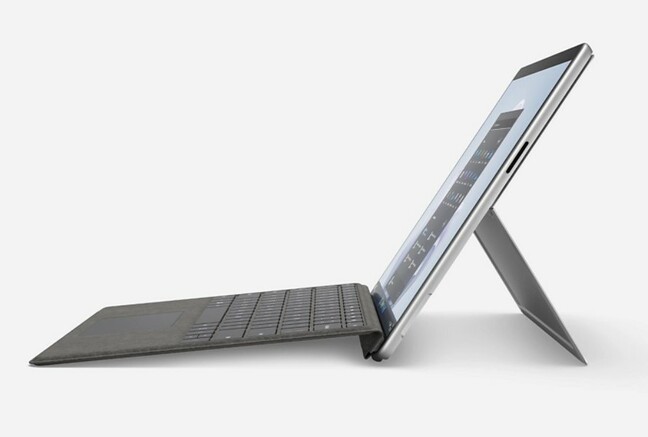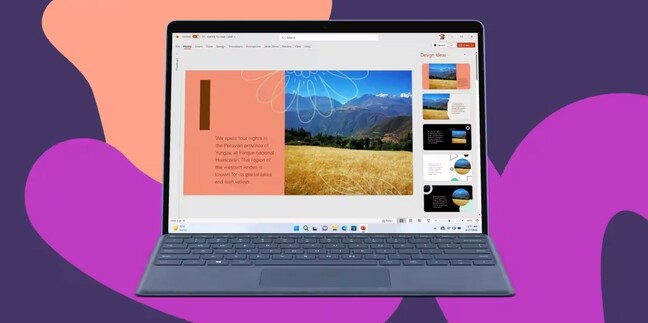Microsoft's Surface Pro 9 requires a tedious balancing act
There's probably someone out there who likes a wobbly laptop that cuts their flesh
Desktop Tourism In one of the documents uncovered during Microsoft's defense of its acquisition of Activision is a slide in which the software giant expresses its desire for "Surface devices to inspire the ecosystem and set the premium bar for quality and innovation."
The Surface Pro 9 won't achieve either goal, I promise.
The machine's main problem is its form factor: it's essentially a tablet computer with a folding flap at its rear so the machine can rest on two points: the edge of the flap, and the base of the tablet. If you add a keyboard, it also rests on the leading edge of the keyboard nearest its user. Here's how that looks:
If used on your lap, the Surface Pro therefore has perhaps 2cm of its surface in contact with your person. That daft arrangement means the Surface Pro 9 has a longer footprint than a conventional clamshell, but literally requires a balancing act to use. Every time I tried to place it on a flat surface, or use it on my lap, I needed to reassess how to stabilize it. And I needed to do that a lot during marathon efforts to acquire Taylor Swift tickets (for one of my kids – no, really).
Even when it was stable it wasn't comfortable because the flap is a couple of millimeters wide so cuts into one's lap just enough to be uncomfortable.
Stabilizing the Surface Pro, then adjusting it to stop the flat cutting into my flesh, quickly became activities I resented.
Complicating matters is that Microsoft's keyboard is suboptimal. In addition to the click of each keystroke, it emits a little knocking sound. And typing on it while lap-mounted just accentuated the instability.
By now you've probably figured out I found the Surface Pro harder to work with away from a desk than any other laptop design. It feels daft.
As always on a Desktop Tourism jaunt, we tested it by using Handbrake to downscale a five minute 4K video to 1080p. The ten-core 2.7GHz Intel Core i7-1265U knocked off that job in a very impressive 2:23. The machine also did brilliantly when running the same test in an Ubuntu VM under VMware Workstation, finishing the job 7:18 – better than some of the Core i9 machines we've used.
The Cinebench benchmarking tool rated it a solid 6063, so at least it's speedy.
But at 879g and 287mm x 209mm x 9.3mm it's too big for one-handed operation as a tablet. I tried to use the flap as a handle. No dice. Doing so also showed me that the machine becomes just a little past pleasantly warm, even under modest workloads, after not many minutes of operation.
Microsoft's made an odd choice by giving the machine a pair of Thunderbolt ports – both of which can power the machine over USB-C – but also including its own proprietary power connector. A USB-A slot would have been a better use of space.
Speakers are pleasant and the screen is fine for touch input and as a display. The machine never stuttered or impinged on my working days. External monitors and Bluetooth devices connected without complication.
- A dip in Alder Lake with an HP Elitebook is spoiled by avoidable mistakes
- Lenovo's Yoga 9 is flexible at home, but stretches the friendship at work
- Your next PC should be a desktop – maybe even this Chinese mini machine
- Are you ready to go all-in, head-first, on a laptop? ASUS's Zenbook Pro 16X asks for that commitment
I see people out and about using the Surface Pro without fuming, so presumably this design works for some people.
If you like the look of this machine, do not buy it unless you can first test it in as many situations or poses as you can imagine needing to put it to work. It's fast, and pretty, and the low-end models are decently-priced at $999 (plus $280 for the keyboard). But that's a false economy if you can't pull off the balancing act required to make the Surface Pro 9 a viable workhorse. ®


 Biting the hand that feeds IT
Biting the hand that feeds IT